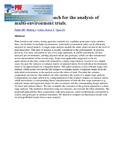A stage-wise approach for the analysis of multi-environment trials.

View/
Date
2012Author
Piepho, HP
Möhring, J
Schulz-Streeck, T
Ogutu, JO
Type
ArticleLanguage
enMetadata
Show full item recordAbstract
Plant breeders and variety testing agencies routinely test candidate genotypes (crop varieties, lines, test hybrids) in multiple environments. Such multi-environment trials can be efficiently analysed by mixed models. A single-stage analysis models the entire observed data at the level of individual plots. This kind of analysis is usually considered as the gold standard. In practice, however, it is more convenient to use a two-stage approach, in which experiments are first analysed per environment, yielding adjusted means per genotype, which are then summarised across environments in the second stage. Stage-wise approaches suggested so far are approximate in that they cannot fully reproduce a single-stage analysis, except in very simple cases, because the variance-covariance matrix of adjusted means from individual environments needs to be approximated by a diagonal matrix. This paper proposes a fully efficient stage-wise method, which carries forward the full variance-covariance matrix of adjusted means from the individual environments to the analysis across the series of trials. Provided the variance components are known, this method can fully reproduce the results of a single-stage analysis. Computations are made efficient by a diagonalisation of the residual variance-covariance matrix, which necessitates a corresponding linear transformation of both the first-stage estimates (e.g. adjusted means and regression slopes for plot covariates) and the corresponding design matrices for fixed and random effects. We also exemplify the extension of the general approach to a three-stage analysis. The method is illustrated using two datasets, one real and the other simulated. The proposed approach has close connections with meta-analysis, where environments correspond to centres and genotypes to medical treatments. We therefore compare our theoretical results with recently published results from a meta-analysis.
URI
http://www.ncbi.nlm.nih.gov/pubmed/23007738http://erepository.uonbi.ac.ke:8080/xmlui/handle/123456789/58239
Citation
Biom J. 2012 Nov;54(6):844-60. doi: 10.1002/bimj.201100219. Epub 2012 Sep 25.Publisher
University of Nairobi School of Computing and Informatics
